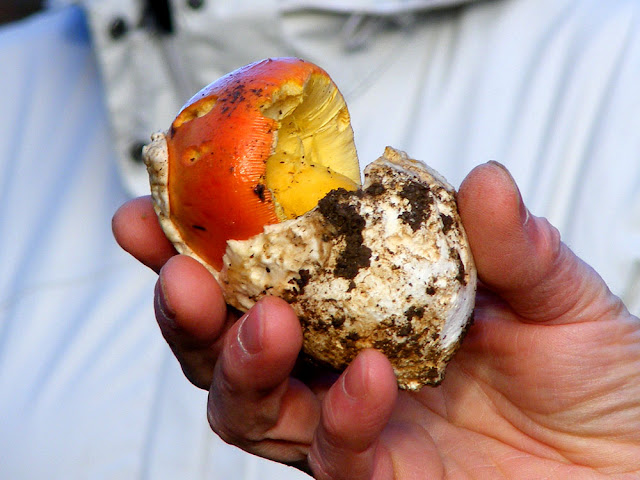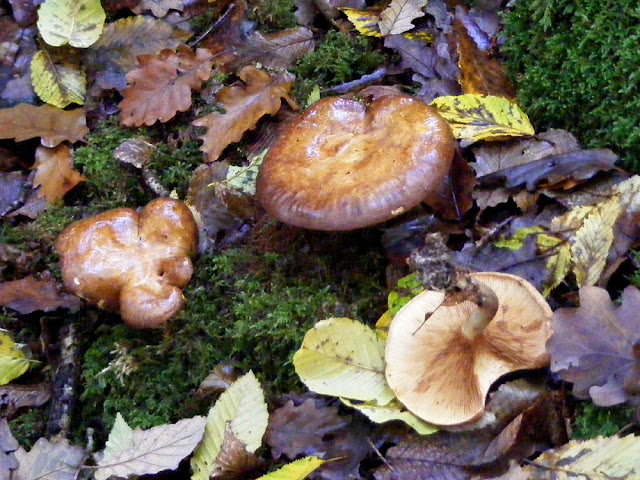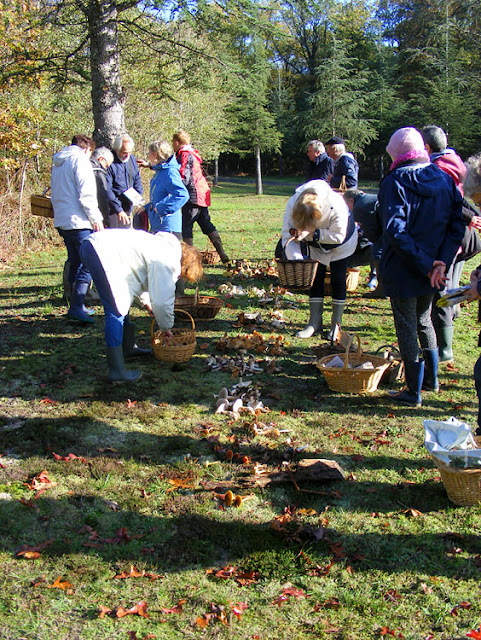Didier Raas, pharmacist and expert mycologist from Loches, lead one of his public education and outreach sessions in the Forest of Preuilly on Tuesday 12 November. It had been very wet, so many mushrooms were not in the best condition, and many were hidden under dead leaves that were stuck together with the wet. In the end though, after a couple of hours of forcing our way through the bracken and brambles deep in the forest we ended up with quite a good haul. Here are some pictures from the morning.
We set out.
Caesars Mushroom Amanita caesarea (Fr. Amanite des césars).
Caesars Mushroom is an uncommon and prized edible species. It is normally eaten as young as possible, when it has a rather egg like appearance. Many white gilled Amanita species are very toxic, but Caesars Mushroom is the only yellow gilled Amanita, making it easy to confidently identify. The only possible confusion is with the infamous Fly Agaric Amanita muscari (Fr. Amanite tue-mouches), which is redder (less orange). But beware -- in rainy weather like this, the white flakes could wash off the cap of the Fly Agaric, making it look much more like the smooth shiny red cap of Caesars Mushroom. It is so important to check gill colour, and beginners should never eat a white gilled mushroom if they have not had it checked by someone like Didier.
Crowded Brittlegill Russula densifolia (Fr. Russule à lames serrées).
This is not an edible species, but mushrooms like this from the Lepiote group poison a lot of people. There is only one edible species of Lepiote, and it seems many foragers are just not careful enough or clued up enough to check for the snakeskin patterned stem that only the edible Common Parasol has. The other thing you should look for when intending to eat a white gilled mushroom that you think is a parasol is that the stem ring will slide up and down intact when gently pushed. If it doesn't then you were planning to eat a toxic Amanita sp.
Brown Roll Rim Mushroom Paxillus involutus (Fr. Paxille enroulé).
This is one of the highly toxic mushrooms. It can kill, and causes an autoimmune response that damages the vascular system and internal organs. Treatment is months long, involves heavy duty drugs and the condition it causes is excruciatingly painful. The species can be identified by the very rolled edge of the cap and the way the gills scrape off very easily.
Brittlegill Russula sp (Fr. Russule).
These purple and red capped brittlecaps are very difficult to identify to species level. The colour of this one would be described in a French field guide as vineuse.
This bolete has been infected with another fungus.
A mushroom in this condition is not good to eat. The mould that has attacked it will have bad flavours and maybe even make you sick.
Crown-tipped Coral Artomyces pyxidatus (Fr. Clavaire couronnée).
Butter Cap Rhodocollybia butyracea syn Collybia butyracea (Fr. Collybie beurée).
This species feels greasy which is why it is known as 'buttery'. The stem is always curved into a hook shape.
Sorting the mushrooms into family groups prior to identifying everything to species level.
Part II will follow.
************************************************
For details of our private guided tours of chateaux, gardens, wineries, markets and more please visit the Loire Valley Time Travel website. We would be delighted to design a tour for you.
We are also on Instagram, so check us out to see a regularly updated selection of our very best photos.
We are also on Instagram, so check us out to see a regularly updated selection of our very best photos.











No comments:
Post a Comment